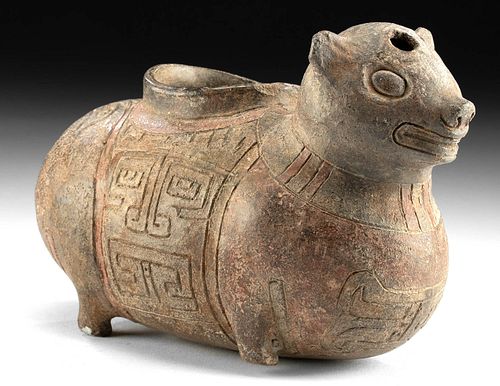Chavin Pottery Incised Jaguar Vessel, TL Tested
Lot 152
About Seller
Artemis Fine Arts
686 S Taylor Ave, Ste 106
Louisville, CO 80027
United States
Selling antiquities, ancient and ethnographic art online since 1993, Artemis Gallery specializes in Classical Antiquities (Egyptian, Greek, Roman, Near Eastern), Asian, Pre-Columbian, African / Tribal / Oceanographic art. Our extensive inventory includes pottery, stone, metal, wood, glass and textil...Read more
Categories
Estimate:
$2,800 - $4,200
Absentee vs Live bid
Two ways to bid:
- Leave a max absentee bid and the platform will bid on your behalf up to your maximum bid during the live auction.
- Bid live during the auction and your bids will be submitted real-time to the auctioneer.
Bid Increments
| Price | Bid Increment |
|---|---|
| $0 | $25 |
| $300 | $50 |
| $1,000 | $100 |
| $2,000 | $250 |
| $5,000 | $500 |
| $10,000 | $1,000 |
| $20,000 | $2,500 |
| $50,000 | $5,000 |
| $100,000 | $10,000 |
| $200,000 | $20,000 |
About Auction
By Artemis Fine Arts
Mar 24, 2022
Set Reminder
2022-03-24 10:00:00
2022-03-24 10:00:00
America/New_York
Bidsquare
Bidsquare : Exceptional Antiquities Ethnographic Fine Art
https://www.bidsquare.com/auctions/artemis-gallery/exceptional-antiquities-ethnographic-fine-art-9057
Museum-worthy examples of classical antiquities (Egyptian, Greek, Roman, Near Eastern), Viking, Far East / Asian, Pre-Columbian, African / Tribal, Oceanic, Native American, Spanish Colonial, Fossils, Ancient Jewelry, Fine / Visual Arts, so much more! Artemis Fine Arts info@artemisfinearts.com
Museum-worthy examples of classical antiquities (Egyptian, Greek, Roman, Near Eastern), Viking, Far East / Asian, Pre-Columbian, African / Tribal, Oceanic, Native American, Spanish Colonial, Fossils, Ancient Jewelry, Fine / Visual Arts, so much more! Artemis Fine Arts info@artemisfinearts.com
- Lot Description
Pre-Columbian, North Coast Peru, Chavin, Santana-Santa River, ca. 700 to 200 BCE. A delightful ceramic vessel in the form of a stylized jaguar presenting a portly body with squat limbs and a sinuous, curled tail. Adorned in red and black slip, the adorable animal boasts incised decoration of stylized designs representing human heads on its sides and a serpent flowing backwards from its chest. Gazing forth from applied, ovoid eyes, the feline exhibits a leering grin of gritted teeth beneath a naturalistic nose and round ears. A pair of petite openings in the head echo the wide-open vessel rim on the animal's back. Size: 7.4" L x 4.6" H (18.8 cm x 11.7 cm)
The Chavin people lived in the northern Highland Andes, and their capital, Chavin de Huantar, is an UNESCO World Heritage Site. The artwork of Chavin represents the first widespread style in the Andes, inspirational to later cultures, especially the Moche. e center of Chavin de Huantar is a massive, flat-topped pyramid, surrounded by lower platforms. Between 1200 and 500 BCE the pyramid space was used for religious ceremonies. The Old Temple, constructed very early in the history of the site, consists of a series of passageways built around a circular courtyard; within were carved stone monuments showing jaguars, serpents, and other figures with transformative and/or anthropomorphic figures. At the very center is a towering stone stela depicting an anthropomorphic figure with a jaguar head and a human body, believed to be Lanzon, the chief deity of Chavin. Researchers believe that worshippers ingested hallucinogenic drugs, ground in mortars like this one, and then were led in the dark through the labyrinthine passageways before entering the central courtyard and coming abruptly face-to-face with the snarling features of the god.
The feline is the most pervasive animal in ancient Peruvian art, associated with military, religious, and political leaders. The jaguar, which in life hunts by jumping at the head of its prey, may have been a symbol of decapitation - another recurring theme in ancient Peru and one present in the incised decoration of this example. Jaguar imagery additionally symbolized power and might throughout the Pre-Columbian world. Warriors, rulers, hunters, and shamans alike associated themselves with this king of beasts, the largest and most powerful feline in the New World.
This piece has been tested using thermoluminescence (TL) analysis and has been found to be ancient and of the period stated. A full printed and bound report is available for $50 to the buyer. Please contact us to request.
Provenance: private Hidden Valley Lake, California, USA collection; ex-private southern California, USA collection, acquired in the 1970s to mid-1980s
All items legal to buy/sell under U.S. Statute covering cultural patrimony Code 2600, CHAPTER 14, and are guaranteed to be as described or your money back.
A Certificate of Authenticity will accompany all winning bids.
PLEASE NOTE: Due to recent increases of shipments being seized by Australian & German customs (even for items with pre-UNESCO provenance), we will no longer ship most antiquities and ancient Chinese art to Australia & Germany. For categories of items that are acceptable to ship to Australia or Germany, please contact us directly or work with your local customs brokerage firm.
Display stands not described as included/custom in the item description are for photography purposes only and will not be included with the item upon shipping.
#170069Repaired and restored from multiple pieces. This is expertly done and almost impossible to discern. Nice remaining original pigment with some light deposits on surface. Excellent preservation of form and motifs. TL holes to bottom of proper right front paw and interior of rim.Condition
- Shipping Info
-
All shipping is handled in-house for your convenience. Your invoice from Artemis Gallery will include shipping calculation instructions. If in doubt, please inquire BEFORE bidding for estimated shipping costs for individual items.
-
- Buyer's Premium



 EUR
EUR CAD
CAD AUD
AUD GBP
GBP MXN
MXN HKD
HKD CNY
CNY MYR
MYR SEK
SEK SGD
SGD CHF
CHF THB
THB















